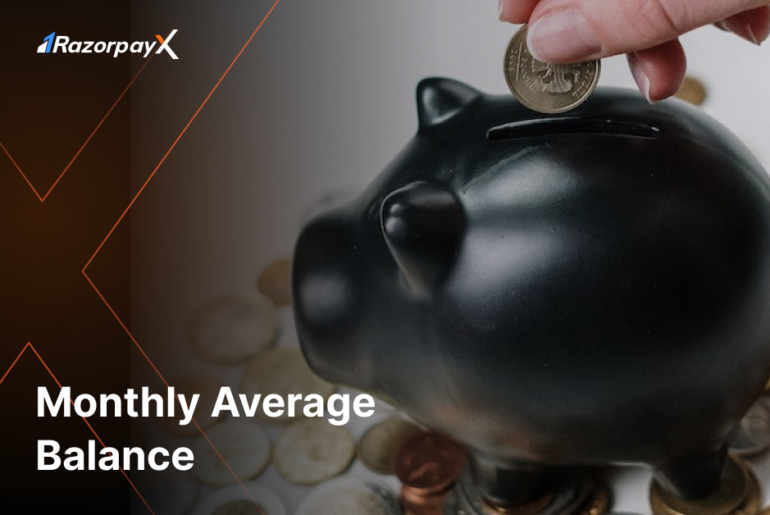Table of Contents
What is Monthly Average Balance?
The monthly average balance is the average closing balance in a bank account over one month. It is calculated by dividing the sum of all closing balances over one month by the number of days in that month.
Banks and financial service providers require businesses to maintain a monthly average balance in their current accounts to continue providing industry-first solutions to businesses.
Some banks provide zero-balance current accounts, which may be attractive to those wanting to avoid fees – but these accounts often lack the advanced features offered by minimum balance accounts.
All businesses should consider minimum balance current accounts to benefit from features like waived transaction fees, faster processing, lesser downtime, better credit ratings etc.
How to Calculate Monthly Average Balance?
Monthly average balance or MAB is calculated with the average of all the closing balances in your account over a month, and dividing it by the number of days in a month.
Monthly average balance formula:
MAB = (Sum of closing balances) / (Number of days in month)
Let’s look at an example to understand this. These were the closing balances in Rahul’s current account for the month of April.
| Days | Total days (A) | Amount in the account at end of the day (B) | A x B |
| First 4 days | 4 | Rs 25,000 | 1,00,000 |
| 5th to 9th day | 5 | Rs 15,000 | 75,000 |
| 10th to 14th day | 5 | Rs 5,000 | 25,000 |
| 15th to 28th day | 14 | Rs 10,000 | 1,40,000 |
| 29th to 30th day | 2 | Rs 20,000 | 40,000 |
Using the formula, monthly average balance comes out to be:
= (1,00,000 + 75000 + 25000 + 1,40,000 + 40,000) / 30
= 3,80,000 / 30
= Rs 12,666.66
Hence, Rahul’s monthly average balance is above the mandated Rs 10,000, and he will not be charged any penalty.
Why do banks enforce a Minimum Average Balance requirement?
A minimum average balance requirement may seem like a hurdle to businesses, but it unlocks valuable benefits.
Businesses that are able to maintain their MAB prove to the bank or financial service provider that the business has a regular and steady source of income and stable spending patterns. Maintaining MAB consistently can contribute positively to businesses’ credit scores, which helps with getting loans or emergency lines of credit.
The minimum account balance is an important source of income for the banks, which enables them to provide special features and services like spending analytics, payroll processing, vendor and invoice management, escrow services, forex services, and more.
By maintaining a minimum balance, businesses are partnering with the bank to access a wider range of tools that can streamline operations, improve efficiency, and ultimately help them grow.
Check out RazorpayX Business Banking+
Tips on Maintaining Monthly Average Balance
While the entire concept of average balance is rather simple, here are some ways in which you can optimise your monthly average balance maintenance and ensure a smooth ride with your bank.
1. Know Your Requirements
Weigh your options before you apply for any bank account. Banks and service providers offer different kinds of current accounts – startup current accounts, premium current accounts, zero balance accounts, forex accounts and more.
Each current account comes with different features, services and minimum balance requirements.
Read more: A Guide to Types of Current Accounts
2. Avoid Multiple Bank Accounts
Avoid multiple bank accounts. This makes it hard to keep track of MAB requirement norms of each bank and comply with them each month. It also results in a large amount of money being locked away as the minimum balance requirement across all your bank accounts.
If you’re a business owner, it’s best to open one single current account that serves all your financial needs.
Explore RazorpayX Business Banking+
3. Budget and Plan
This one goes without saying – make sure your expenses are optimised and you’re accounting for every rupee that goes out of your account! Saving money wherever possible will help you maintain a higher average balance in your account.
Robust current accounts come with accounting integrations, which automatically record and reconcile every transaction into your accounting software of choice. RazorpayX Business Banking+ integrates with all the top accounting software, including Zohobooks, Tally and more.
4. Use Credit to Your Benefit
Current accounts come with a corporate credit card, which can help with short-term expenses and purchases without putting your bank balance at risk. Be careful while using a corporate credit card – overspending can put your cash at risk when its time to pay your dues.
5. Focus on cashflow management
Well-managed cash flow will ensure your business always has a surplus of cash to maintain the minimum balance requirement. An important part of managing cash flow well is making your business payments on time and managing your budget well.
With RazorpayX Business Banking+, you can automate budgeting, vendor payments, payroll, general payouts, and more, making business finances easier to manage.
Check out RazorpayX Business Banking+
Penalties for Non-Maintenance of Monthly Average Balance
Since the monthly average balance requirement differs from bank to bank, the penalty charges are also different for each bank. Here’s a look into what non-maintenance penalties look like for account holders in India’s top banks.
| Name of Bank | Account Type | Non-Maintenance Penalty |
| ICICI Bank | Regular Savings Account | 6% of the shortfall in required MAB or Rs 500 whichever is lower |
| Current Accounts | Rs 750 – Rs 3,000, depending on type of Current Account | |
| Yes Bank | Current Accounts | Rs 1,500 per quarter |
| RBL Bank | Current Accounts | Rs 1,000 if Quarterly Average Balance is below 50%
Rs 2,000 if Quarterly Average Balance is above 50% |
| HDFC Bank | Regular Savings Account | 6% of the shortfall from the average balance requirement or Rs 600 whichever is lower |
| Regular Current Account | Rs 1,500 | |
| State Bank of India | Current Accounts | Rs 500 – Rs 8,000, depending on type of Current Account |
*as mentioned in official websites
Monthly Average Balance (MAB) vs Quarterly Average Balance (QAB)
It’s important to understand the differences between current accounts with a monthly average balance requirement and those with a quarterly average balance requirement.
QAB offers more flexibility, since the time period is much longer – allowing for more fluctuations in individual months. Businesses with seasonal income patterns or occasional large disbursements like construction companies working on a project basis would benefit from using a QAB current account.
MAB requires maintaining a specific minimum balance each month, which encourages consistent financial management. MAB accounts also come with added features and better interest rates.
RazorpayX Business Banking+ partners with ICICI Bank, Axis Bank, Yes Bank, and RBL Bank to provide you with a selection of current accounts for your business.
Check out RazorpayX Business Banking+
Benefits of Maintaining Monthly Average Balance
Maintaining a monthly average balance (MAB) in your account can offer several advantages:
Financial Discipline: The requirement to keep a minimum average balance can nudge you to be more mindful of your spending. You’re less likely to make unnecessary withdrawals if you know it might affect your MAB and trigger penalties. Over time, this can lead to better budgeting habits and potentially increased savings.
Earning Potential: Some banks offer higher interest rates on savings accounts with a maintained MAB. This means you earn more money on the funds you keep in the account.
Access to Perks: Many banks reward customers who maintain a good MAB with benefits like free ATM transactions, waived monthly maintenance charges, or even cashback offers. These perks can help you save money on banking fees.
Exclusive Products: Meeting the MAB requirement might unlock access to exclusive financial products like higher loan limits or investment options with better rates.
Improved Creditworthiness: Though not a direct impact, maintaining a good banking history, including keeping a steady MAB, can be a positive factor for your credit score. This can make it easier to secure loans and credit cards in the future.
Safety Net: Having a buffer in your account through the MAB can be a safety net for unexpected expenses. You’ll have some readily available funds to handle emergencies without dipping into other savings or incurring debt.
Zero Balance Bank Accounts
If the concept of a minimum balance sounds too daunting for you, don’t worry.
Banks also offer zero-balance bank accounts without an MAB, meaning accountholders can maintain a nil balance without incurring penalties.
Read more: Zero Balance Accounts – An Explainer
Keeping a minimum balance is important, so it’s important to select the right kind of current account. The ideal current account is a one-stop shop, providing your business with solutions to every financial problem you might face.
FAQs
What is monthly average balance?
Monthly Average Balance is the minimum amount of funds that account holders must maintain to avoid being penalized by the bank.
Do I need to maintain the MAB every day in a month?
No. Since the daily closing balance is averaged out, the account holder may have more funds than MAB on some days that can make up for the shortfall on some days.
Where can I check the monthly average balance requirement for my account?
Account holders can opt for mobile banking, internet banking, or call the customer care center of their bank to know about the MAB requirement.
How is monthly average balance calculated by my bank?
Banks use the formula: MAB = (total of end of the day closing balances) / (number of days in one month) to calculate the MAB of an account holder.





